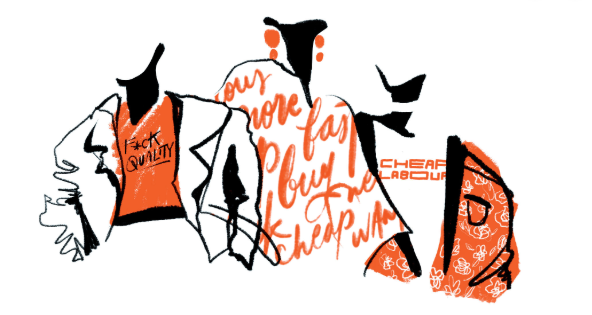Fast Fashion is Ruining Our Earth

Photo via: http://www.capilanocourier.com/2017/11/27/fast-fashion-zara-employees/
October 3, 2019
Trends pass by teens and millennials everyday. Something is “in” one day and “out” the next. This is the basic concept of fast fashion. Fast fashion is inexpensive clothing produced rapidly by mass-market retailers
in response to the latest trends. In the past 15 years, the average number of times a garment is worn before it ceases to be used has decreased by 36% (Elle MacArthur Foundation 2017). Trends come and go, but our earth does not. Although these clothes may be with the times, the environmental effects can be devastating to our planet.
The production of fast fashion is one of the leading causes of pollution. The global apparel and footwear industry accounts for 8% of the world’s greenhouse gas emissions releasing four metric gigatonnes of CO2 into the atmosphere (Quantis 2018). The carbon emissions that these textile factories give off is another contributing factor to climate change and the devastation of our earth. The fashion industry is the third highest polluting industry in the world. Along with physical production, the materials used to make these cheap, mass produced clothes also affects our environment. Of the total fiber input used for clothing, 87% is landfilled or incinerated costing $100 billion annually (Elle MacArthur Foundation 2017). This concept is a huge problem that not many people are aware of. The fashion industry’s CO2 emissions are projected to increase to nearly 2.8 billion tons per year by 2030— equivalent to the emissions of 230 million passenger vehicles driven for a year (Global Fashion Agenda 2017). With this statistic, we see that this problem is not being addressed. Thousands of people contribute to this problem because of their lack of awareness.
Along with the manufacturing and producing of textiles, the fact that trends are only relevant for a short amount of time means that millennials are constantly buying new clothes, and getting rid of the old. Most fast fashion textiles are made of synthetic fibers, which is not decomposable. This means that it will sit in landfills for years and years to come. Nearly 60% of all clothing produced ends up in incinerators or landfills within a year of being made. Trends come and go so fast that this cycle will continue for years to come unless this environmental problem is spotlighted. The solution to this neverending problem is sustainable fashion.
There is not one single definition for sustainable fashion, but it is basically focusing on the process of making a change to the fashion industry towards greater ecological integrity and social justice. This can include shopping second-hand at a thrift store, or buying clothes made of sustainable, recycled fabrics. Sustainable fashion is a very wide term, but can be divided into seven main categories- custom made, or D.I.Y. (do it yourself), clean natural products, a high quality product with a timeless design, fair and ethical practices, redesign and upcycle, swap and lease, and second-hand and vintage. When shopping, try to see if the product fits into these categories of sustainability. Thrifting and upcycling are great ways to have a unique and environmentally friendly closet. Many teenagers thrift and look for vintage pieces. Are we already starting to break the cycle of fast fashion? The fashion industry’s environmental and social problems have been looked past for years- let this generation be the change you didn’t know that we needed.



Jonathon Zapf • Oct 26, 2019 at 2:11 pm
Or you could just where the same hoodie every single day like me.